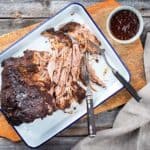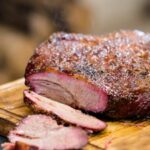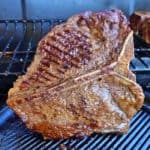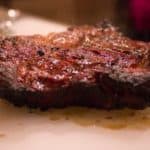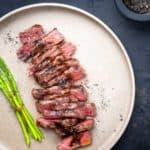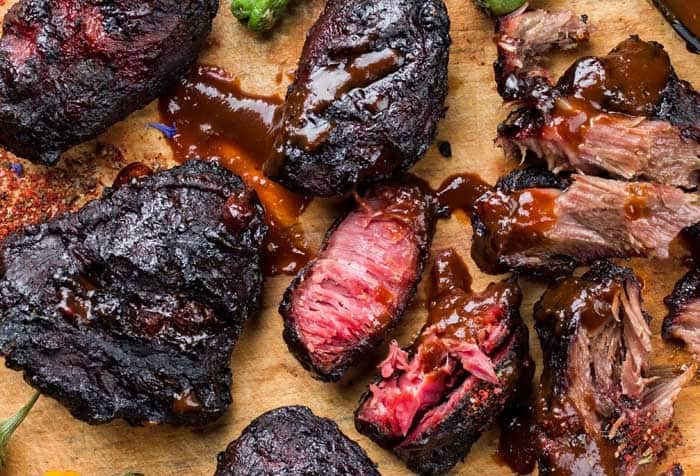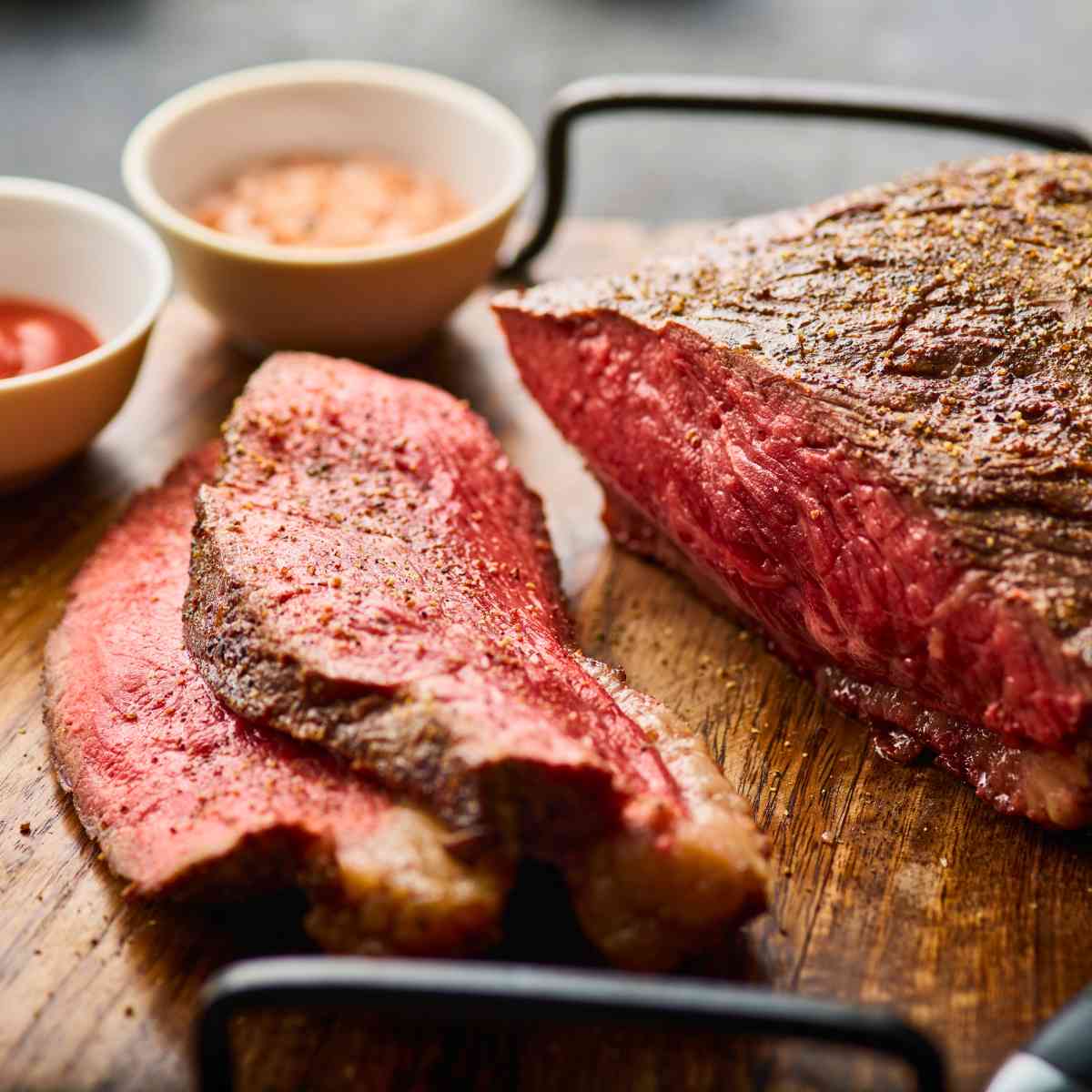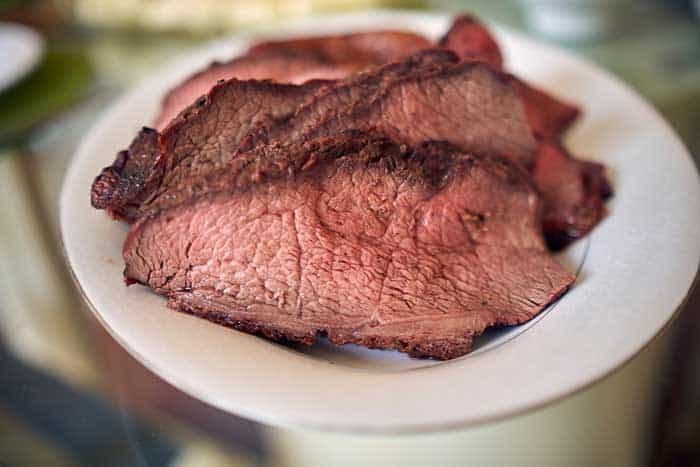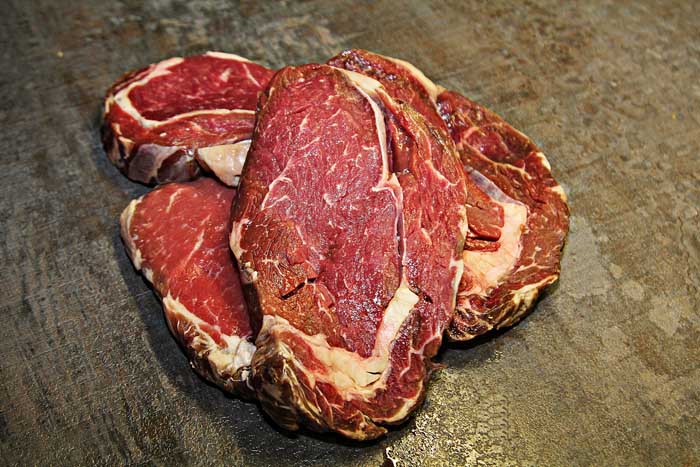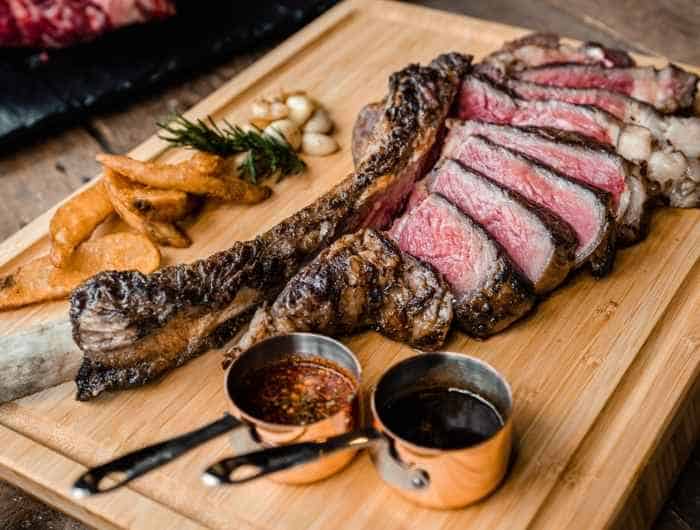Wagyu beef is known for its unparalleled tenderness and beefy flavor, making it one of the most prized meats in the world. Find out what sets Wagyu beef apart with our beef cut guide.
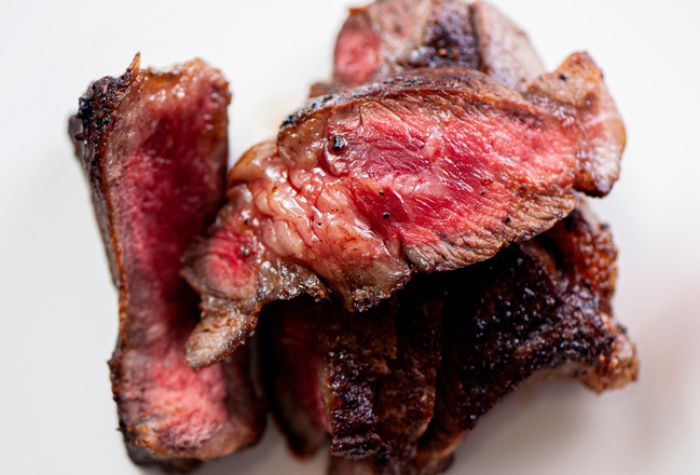
If you’ve heard of Wagyu beef, you probably know it’s the ultimate luxury-tier meat, but do you know why?
Wagyu is the Champagne of the beef world. Just as wine can only be labeled ‘Champagne’ if produced in the Champagne region of France, beef can only be called Wagyu if it comes from specific Japanese cattle breeds.
Not only does the beef need a particular heritage to be labeled Wagyu, but it must also meet strict grading criteria.
Discover what makes Wagyu beef so unique, why it stands out from other types of beef, and where to find the finest Wagyu steaks.
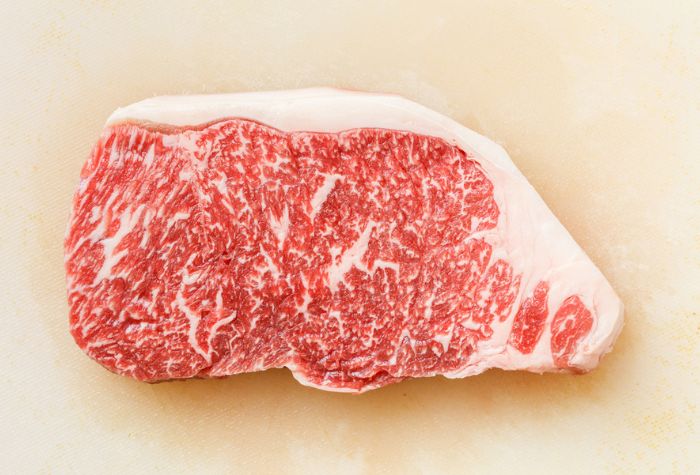
What is Wagyu Beef?
Wagyu beef is beef from particular breeds of Japanese cattle. It is highly valued for its intense marbling, butter-like texture, and unique umami flavor.
Wagyu beef in Japan is produced from one of four breeds of cattle – the Japanese Black, Japanese Brown, Japanese Polled, or the Japanese Shorthorn.
American Wagyu is produced from cattle that are a crossbreed of Japanese Waygu and traditional American cattle such as Angus. This crossbreeding gives the same amazing quality of tender, marbled beef but with a more robust flavor that resembles the taste of traditional American beef.
Wagyu vs. Kobe Beef
Kobe beef is a specific type of Wagyu that comes from cattle in the Kobe city region of Japan.
Kobe beef cattle are raised in a way that gives their meat a slightly different taste to other Wagyu breeds. It’s often described as having a more creamy taste and texture than similarly rated A5 Wagyu beef.
Wagyu vs. Angus
Angus and Wagyu are names used to refer to two different breeds of beef cattle.
Angus breeds originally came from Scotland to the US in the late 1800s are now the most popular breed in the country. They produce tender and delicious beef with fantastic marbling that is graded using the USDA scale.
Wagyu breeds of cattle are from Japan and first came to the US in 1975. They produce beef that is famous for its intense marbling and unique flavor and texture. Wagyu beef is graded using the Japanese BMS scale.
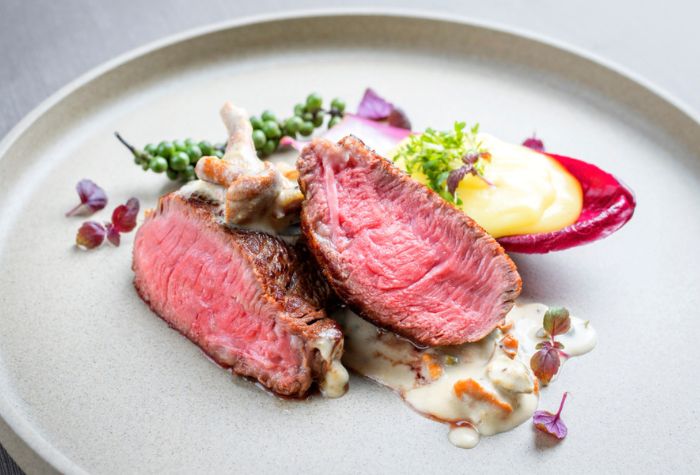
What is Special About Wagyu Beef?
Wagyu beef is considered to be the most luxurious and best-tasting beef in the world. It’s juicer, more tender, and has a stronger taste than regular beef. This is all down to one key characteristic – fat marbling.
The intense fat marbling in Wagyu beef comes from meticulous breeding and cattle-raising practices. Wagyu cattle live stress-free lives – they are free to graze and roam in large pastures and are continually monitored and cared for by expert farmers.
You might have even heard that Wagyu cattle get massages from the farmers – this isn’t exactly true, but it’s not entirely false either! Wagyu cattle are a working breed, and the dense fat marbling in their beef is partly due to their regular exercise.
Large amounts of open farmland can be scarce in Japan, and winters can be harsh, meaning the cattle spend more time in pens rather than roaming freely in pastures. If farmers feel like the cattle aren’t getting as much exercise as they should be, they will sometimes use a stiff brush to work the cow’s muscles in order to stop them from cramping or seizing up.
The marbling found in Wagyu is a softer fat with a lower melting point than is found in other types of beef. When cooked, this fat renders into the meat, making it incredibly tender and infusing an intense flavor.
Differences between Japanese, American & Australian Wagyu
The main difference between Japanese Wagyu and Wagyu from anywhere else in the world comes down to the cattle themselves.
Japanese Wagyu comes from purebred cows, whereas American or Australian Wagyu will come from crossbred cows.
Non-Japanese Wagyu will still have an intense flavor and dense marbling but not as exceptional as true Japanese Wagyu.
History of Wagyu
Cattle were originally introduced to Japan from China around the second century AD and used only as working animals until the late 1800s.
Between 1868 and 1887, a small number of foreign cattle were imported into Japan for use as meat and dairy cattle. There were no plans to breed the native species of cattle with the foreign imported cattle at first, as they both served different purposes.
This changed in 1900, and farmers began to crossbreed the cattle, which resulted in larger animals with better dairy production. The crossbreeding of cattle was then quickly stopped in 1910 when it became apparent that, although they were bigger and had higher dairy production, they weren’t as good for use as working animals and produced lower-quality meat.
In 1919, the different regional populations of crossbred cattle were declared as ‘Improved Japanese Cattle’ and broken down into four distinct types.
These types were based on which breed of foreign cattle the cross breeds had been produced from and were later given individual breed status in 1944.
The four breeds are:
- Japanese Black (Kuroge): Accounts for around 94% of the beef cattle population in Japan.
- Japanese Brown (Akage): Also known as the Japanese Red, is the other main cattle breed in Japan, making up around 5% of the population.
- Japanese Shorthorn (Nihon Tankaku): These cattle are reared in northern Japan and comprise less than 1% of the population.
- Japanese Polled (Mukaku): The rarest of all Wagyu breeds, these cattle are a crossbreed of Japanese Black and Aberdeen Angus cattle imported from Scotland in the 1920s. They are the rarest of all Wagyu breeds.
Collectively these four Japanese breeds of beef cattle are called Wagyu, with the name Wagyu literally translating to ‘Japanese Cow’.
Wagyu cattle were first introduced to the US in 1976. Four Wagyu bulls were bred with American cattle; their resulting offspring became the first American Wagyu cattle.
In 1993 the Japanese government allowed other countries to import female Wagyu cows, which resulted in the first pure-breed Wagyu cattle in the US.
In 1997 the Japanese government declared Wagyu a ‘National Treasure’ and banned any further exports of Wagyu cattle genetics (including sperm and embryos, as well as live cattle).
Wagyu cattle can be found elsewhere in the world. Countries such as Australia, Canada, and the UK could import purebred Wagyu cattle until the ban was implemented and have created their own hybrid Wagyu bloodlines.
Grades of Wagyu Beef
Wagyu beef is graded in a particular way – it’s given a beef marbling score (BMS) and a Yield and Flesh rating.
Beef Marbling Score
The beef marbling score is a Japanese scale used to rate the level of marbling in the meat. The scale ranges from 0 – 12, with twelve being the highest grade possible for Wagyu beef.
To give you an idea of how that ties into beef available in the US – the sort of beef marked as USDA prime would range from 4-5 on the BMS scale, while something like Kobe beef would have to be at least a 6.
Wagyu beef needs to have a BMS of 6 and over.
Yield and Flesh Rating
The yield letter rating measures the weight of the beef as a percentage.
The best yield is scored as ‘A’ and is considered superior meat, ‘B’ would be an average grade meat, and ‘C’ would be classed as inferior meat.
The flesh rating gives a number score to the meat’s overall texture, color, and gloss. An inspector is looking for the level of marbling, how evenly it’s distributed through the meat and the beef’s overall color.
Wagyu Beef can be rated either A4 or A5, although A5 is rare and difficult to obtain as a score.
Where to Buy Wagyu Beef
If you’re looking to buy Wagyu beef in the US, you want to ensure you use a reputable company. One of the supplies we recommend for quality meat is Snake River Farms.
American Wagyu Beef from Snake River Farms is given a grade of Black or Gold: Black is for any cut that has a BMS of 6 – 8; this would be classed as A4 Wagyu. Gold is for a cut that has a BMS of 9 and over; this would be classed as A5 Wagyu.
Here are some of their most highly rated and best-reviewed cuts of Wagyu beef:
- Filet Mignon: This A4 Wagyu filet mignon is so fine-grained and tender that it can be cut with a fork! Steaks come fully trimmed and are sliced to 2 inches thick for optimal cooking time.
- Cowboy Steak: If you’re looking for a show-stopping steak, you can’t go far wrong with this A5 Wagyu Cowboy Steak. This weighty bone-in ribeye is one of the highest-graded Wagyu cuts available from Snake River Farms. With a BMS of 9+, a full-bodied flavor, and a soft buttery texture, it’s a cut you won’t regret buying.
- Flat Iron: The flat iron isn’t a cut you’ll come across too often when dining out, but that’s because it’s one of the butcher and beef experts’ best-kept secrets! Flat iron steak has been scientifically proven to be the second most tender steak (with filet mignon taking first place) – so you know you’re on to a winner with this A4 Wagyu Flat Iron steak.
Wagyu Beef Recipes
Not sure where to start with cooking wagyu beef? Here are our best wagyu beef recipes and ideas to help you get the most out of this elite-level meat:
- Proof that keeping things simple can yield the best results, our grilled wagyu steak is prepared with just a simple salt brine before it’s reverse seared for the perfect match of tender meat and charred finish
- What better way to elevate your burgers than to use ground wagyu beef? Keep it light on ingredients by using just a simple seasoning blend for your grilled Wagyu burger, and go easy on the toppings – we want to let that beef sing.
- Try using wagyu on skewers to ensure that every bite of your BBQ kabob is rich and juicy
